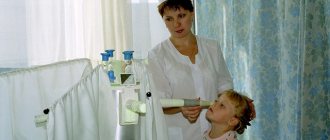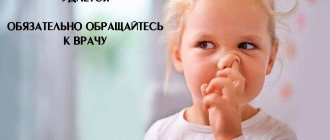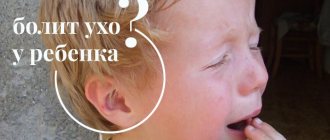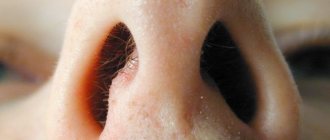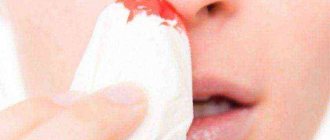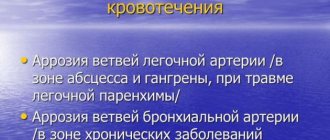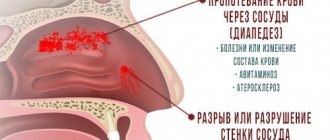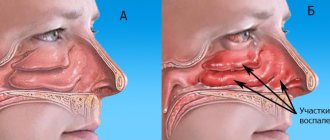Every person on Earth has had a nosebleed at least once in their life. The phenomenon is unpleasant, but often not at all threatening to life and health. The nose is located on the face and protrudes beyond the skull, so it is easily injured. Even a minor push or blow can cause bleeding. However, there are other more serious situations, as well as diseases accompanied by nosebleeds.
Today we will talk about the reasons why nosebleeds occur and how to help. How to quickly stop nosebleeds in a child or adult, and how to do it correctly.
Causes of nosebleeds in adults
Injury. A slight collision of the nose with a hard object causes bleeding. It is not necessary that bones will be broken or cartilage tissue destroyed. If the injuries are severe, due to a powerful blow, then there is a risk of developing dangerous bleeding from deeper and larger arteries and veins.
Overheating in the sun. If a person is exposed to the scorching sun for a long time, and also physically strains at the same time, then nosebleeds can be expected. Frequent inhalation of hot air has a detrimental effect on the mucous membrane, drying it out, and small blood vessels rupture.
Prolonged runny nose, due to infection or allergies, depletes the mucous membrane, which leads to fragility of blood vessels.
Vascular diseases, or rather, diseases leading to failure of the vascular wall. These are usually long-term systemic diseases.
Disturbances in the blood coagulation system. Hemophilia is a disease in which the blood does not clot. This leads to long, debilitating bleeding.
Lack of vitamin K. This vitamin is involved in the process of blood clotting. If there is not enough vitamin due to intestinal and liver diseases, then the patient is accompanied by minor bleeding of different locations.
Lack of vitamin C. This vitamin plays a role in the resistance and strength of blood vessels.
Acute respiratory diseases and influenza. The viruses that cause influenza by nature have a toxin that destroys blood vessels.
Liver diseases. The liver synthesizes many blood clotting factors. One of the criteria for liver function is the patient’s blood clotting rate and frequent nosebleeds.
Inflammation of the bacterial nature of the nasal cavity and paranasal sinuses. This is the well-known sinusitis, frontal sinusitis, ethmoiditis.
Long-term increase in blood pressure. People suffering from hypertension experience constant tension in the vascular wall, including sudden changes in blood pressure. Over time, the vessels become fragile and brittle. Bleeding occurs not only in the nasal cavity, but also in the brain, and this often leads to death.
Vegetovascular dystonia. Vascular destabilization, either low or too high pressure, negatively affects the entire body and causes fragility of blood vessels.
Malignant neoplasms that cause disruption of the liver, bone marrow and other organs.
Long-term use of medications that affect the vascular wall and blood clotting. An example is aspirin, a drug often taken to prevent heart attacks.
Benign neoplasms of the nasal mucosa: papillomas and inflammatory polyps.
Folk remedies for nosebleeds
If you experience nosebleeds, use proven traditional methods. Due to the natural composition, it is possible to quickly eliminate the problem.
No. 1. Nettle
Extract the juice from the fresh leaves of the plant. Moisten the cotton wool and make turundas. Insert them into the nasal passages for a quarter of an hour. Repeat if necessary.
No. 2. Yarrow
Rinse the plant and dry. Grind using a blender/meat grinder. Squeeze out the juice. Place 6 drops into each nostril. The result will not keep you waiting long.
No. 3. Lemon
Freshly squeezed juice does the job perfectly. It is prohibited to use it in its pure form, otherwise you may experience a burn to the mucous membrane. Dilute the juice with filtered water in a ratio of 1 to 2. Place 4 drops into each passage.
No. 4. Aloe
Squeeze the juice from a mature plant, dilute with the same amount of boiled water. Place a few drops into each nostril.
No. 5. Comfrey
Pour in 0.2 l. boiling water 1 tbsp. l. dried plant. After cooling to room temperature, filter. Inject 3 drops into the nasal canals.
Causes of nosebleeds in children
Why do noses bleed in children?
The reasons can be very different: from minor injury and overheating in the sun, to serious illnesses. It is important to identify the problem in time and provide the child with the necessary help.
Foreign body entering the nose. Children, especially young ones, tend to put beads, small parts of toys or other objects into their noses for research purposes.
Overheating in the sun. Just like adults, children should not be in the sun without a hat, and in combination with vigorous physical activity and games, this is dangerous to health.
Dry indoor air. This is especially true during the cold season, when additional heaters are turned on.
Overwork – both mentally, emotionally and physically.
Changes in hormonal levels in a child during puberty.
Anemia of various etiologies.
Disorders of the gastrointestinal tract. This disrupts the production of vitamins necessary for blood clotting.
Diseases and conditions associated with blood clotting disorders.
Kidney disease and systemic autoimmune diseases, which result in increased blood pressure.
Nose injuries. Children are most susceptible to injury to the nose and its mucous membranes.
Main reasons
A common cause is external trauma to the nose. There are a number of diseases that may cause frequent hemorrhages. We list the possible etiological factors:
- Injuries leading to disruption of the integrity of the skin, soft tissues, capillaries, and mucous membranes.
- Surgical intervention, conducting examinations through the nostrils using special instruments.
- Entry of a foreign body into the nostril. First aid for nosebleeds in this case is carried out after removing the object.
- Inflammation of the upper respiratory tract, in which the mucous membrane becomes irritated and swollen.
- Strong and regular nose blowing.
- Excessive or prolonged use of vasoconstrictor drugs (sprays, drops).
- Frequent inhalation of too cold or hot, dry air due to professional activities.
- Anomalies of the structure of the nose.
- The appearance of neoplasms.
- Bad habits, for example, regularly inhaling powdered drugs through the nose.
If we talk about systemic causes that require first aid for nosebleeds, these include chronic diseases (for example, high blood pressure). This also includes poor blood clotting, excessive capillary fragility, vitamin deficiency, and high body temperature.
Bleeding may indicate local problems, including:
- entry of a foreign body;
- nasal injury;
- abuse of drugs by nasal route;
- pathologies of the mucous membrane and adjacent blood vessels;
- features of the anatomical structure of the nasal cavity;
- malignant or benign neoplasms.
In addition, epistaxis (nosebleeds) becomes a consequence of general disorders of the body, including:
- disruption of the cardiovascular system;
- kidney diseases; respiratory tract diseases;
- influenza, ARVI and other colds;
- blood diseases;
- lack of vitamins.
It can be concluded that bleeding indicates both major and minor disorders. Of course, regular nosebleeds are accompanied by serious problems that require special attention.
Doctors have noticed that in the vast majority of cases, nosebleeds are more often recorded in older people and children under adolescence. Women are more susceptible to this phenomenon than men, which is caused by characteristic differences in organisms.
Degrees of danger of nosebleeds
Bleeding from the nose can appear both during complete rest and during active movements or a sudden change in body position to a vertical position.
Why are nosebleeds dangerous?
Depending on how much blood was lost in total, four degrees of severity are distinguished:
- Mild bleeding. This is when the blood loss is no more than a few drops. There is no danger to life, the only thing that can be fear and anxiety. This is especially important when it comes to children. In addition, there is a category of people who are very afraid of the sight of blood and may even faint.
- Moderate blood loss. In this case, no more than 180 ml are lost. This is quite a lot, especially for children. The person may feel dizzy, have a racing heart, and have pale skin.
- Intense bleeding of high risk. Loss over 300 ml. These are usually serious injuries with a fracture of the nasal bone and rupture of large vessels. The patient hears tinnitus, severe weakness, dizziness, increased respiratory rate, shortness of breath. The condition requires immediate emergency care, otherwise the condition will worsen.
- Profuse bleeding. This is an extreme condition with a real threat to life. Blood pressure drops, changes in internal organs are observed. The functioning of the heart and kidneys is impaired. If the patient is not provided with urgent qualified assistance, he may die.
What to do for nosebleeds in adults
When a nosebleed occurs, immediate help is needed. The assistance algorithm for adults and children is somewhat different.
Give a fixed position to the head. It is strictly forbidden to throw your head back due to the risk of swallowing a large mass of blood into the stomach and aspiration into the respiratory tract. To do this, sit the person on a chair and press the head with your hands, slightly tilting it down.
Mechanical fixation to the nasal septum. With minor injuries and insignificant amounts of blood loss, blood comes from one nostril. Press your finger firmly against the septum and wait until the bleeding stops.
Cold compress on the nose. When exposed to low temperatures, the vascular wall contracts and blood flows in less, which contributes to the rapid formation of a blood clot and stops bleeding. Dry ice or ice cubes from the freezer are suitable for this. The compress is placed on the bridge of the nose, always in a towel to prevent frostbite.
On a note!
You can make a simple device if there are children in the house and there is a high risk of minor injuries. To do this, take a medical glove and pour water into it. Tie it in a knot and put it in the freezer. This compress should be kept for no longer than 20 minutes.
Contrast baths. If the cause of bleeding is supposedly high blood pressure, then to quickly eliminate this problem, use contrast baths for the arms and legs. The patient's hands are immersed in cold water, and his legs, respectively, in hot water. In this case, the bloodstream is somewhat rebuilt, and the blood flows to the lower part of the body. This method is good for chronic patients with hypertension syndrome, if there are no usual medications at hand, and for people who have bleeding due to overexertion.
Hydrogen peroxide. Turundas or tampons soaked in 3% hydrogen peroxide. This solution has a good hemostatic agent. The method is good for use at home, especially for children, because this solution does not cause pain or burning. Wet the swab and carefully insert it into the nasal passage for no more than 15 minutes.
Remedies for the common cold. Every home medicine cabinet contains a remedy for the treatment of a runny nose; they constrict blood vessels and that is why the swelling of the mucous membrane goes away. But the remedy will have an effect only with minor capillary bleeding.
Note!
If the blood does not stop, or flows out under great pressure, you should immediately call an ambulance. You can’t do this without qualified medical care.
Means to stop nosebleeds
Drug therapy is the main and most effective method of eliminating nosebleeds. This medical tactic is used when first aid methods are ineffective. People experiencing nosebleeds of various etiologies are recommended to use the following medications:
- Aminocaproic acid. This medication is used for intravenous administration. A hemostatic effect can be achieved by instilling acid into each nasal passage.
- Dicynone. This medication is available both in tablet form and in the form of an injection solution. The use of Dicinon is carried out when it is necessary to urgently stop bleeding in case of high intensity. If necessary, the medicine is used for several days.
- Vikasol. This drug is not suitable for emergency medical care for massive nosebleeds, but it is recommended to be used as an additional component of therapy. The effect of the drug is noticeably felt no earlier than 12 hours after administration.
- If this complication occurs due to pressure, then medical specialists prescribe antihypertensive drugs. These drugs include Clonidine, Corinfar, Nifedipine. In addition, injection administration of Dibazol and magnesium sulfate is recommended.
To eliminate such complications, blood plasma is often used. To do this, they practice introducing tampons pre-moistened in blood plasma into the nasal passages.
This treatment is based on the fact that human plasma contains clotting factors. It is especially difficult to stop bleeding in a drunk person, since alcohol dilates blood vessels and stimulates blood loss.
As alternative means, a biological antiseptic swab, hemostatic sponge and fibrin film are used. Each of these items is made from dried blood plasma. If this problem occurs in a pregnant woman, then local exposure is the safest.
To prevent disseminated intravascular coagulation in case of extensive bleeding, the drugs Trasylol and Contrical are used.
In addition, the following options are used in medical practice:
- Oxygen therapy. This technique is based on inhaling a stream of oxygen through the nose. The bleeding stops within a short time.
- Tamponade. This technique is performed by an otolaryngologist in a medical facility. For tamponade of the nasal cavity, a hemostatic sponge or cotton-gauze swabs are used. The essence of this method is to block the nasal passages along their entire length.
Nosebleeds in children - first aid
How to stop a child's nosebleeds
If the child’s nose bleeds, the behavior tactics are somewhat different. It is necessary to correctly assess the situation and determine how much the situation threatens the child’s life and health. In any case, first of all, you need to calm the baby, who probably thinks that something terrible is happening to him.
- reassure the child in a calm and confident voice;
- sit the child upright, under no circumstances put him to bed; if the child is small and cannot sit on his own, sit him on your lap;
- put cold on the bridge of the nose for no more than ten minutes;
- use tampons soaked in hydrogen peroxide or instill vasoconstrictor drugs.
It is important! If the bleeding has not stopped after fifteen minutes, call emergency help. Do not be afraid to disturb the ambulance workers, because bleeding can cause serious harm to the child.
Do not be indifferent, if you see that a child who is stranger to you, unaccompanied by his parents, is crying and bleeding, be sure to help the baby. This will be especially true in the summer, when children walk outside for a long time and often without a hat.
What not to do if you have a nosebleed
There are things you should not do if your child has a nosebleed:
Under no circumstances should you throw your head back. It is not scary if a small amount of blood gets into the child’s mouth or even stomach. It is dangerous for blood clots to get into the respiratory tract. even when it comes into contact with the back wall of the throat, blood irritates the receptors and causes a cough.
For the same reason, you should not lie on your back. If your baby is very upset or his condition is so bad that it is difficult for him to remain upright until the ambulance arrives, place him on his side.
It is important to know!
Do not insert dry cotton swabs into your nostrils. Of course, at first the blood will quickly saturate the cotton wool, but then it will dry out and by removing the tampon you will destroy the newly formed blood clot. This will cause pain and a new stream of nosebleeds.
And also about the time during which we wait for an ambulance. Try to distract the little person from the sight of blood. Give him ice cream or juice, let him play games on the tablet.
How to quickly stop nosebleeds at home? First actions
You can prevent the development of complications in a person during epistaxis if you know how to stop nosebleeds in an adult at home.
There are several methods for eliminating the violation, which must be used one by one, strictly following the instructions. Let's take a closer look at how to behave when providing first aid.
- We fix the patient's head in a comfortable position. To do this, you shouldn’t tilt it back, as most people do. Pulling the head back can only aggravate the situation, as there will only be a false appearance of stopping the bleeding. In fact, it will continue to flow, but not from the nostrils, but along the back wall of the nasopharynx. This may cause bloody vomiting. There is a high risk of blood reflux into the respiratory tract. To protect the patient as much as possible from unpleasant complications, he should be seated upright in a chair or placed on a high pillow and his head on his side, this will minimize the possibility of choking on his own blood.
- We close our nostrils. Before stopping nosebleeds at home, you need to find out from which nostril the discharge is more abundant. It is this part of the nose that needs to be gently pressed to the bridge of the nose; you cannot press too hard so as not to damage the capillaries.
- Apply a cold compress. Cold acts as a vasoconstrictor, so it can be used to eliminate epistaxis. Take a bag filled with ice or a cloth soaked in cold water and place it on the bridge of your nose. Next, apply a compress to your neck, this will help reduce pressure. Wrap a towel soaked in cold water around your neck. The patient should sit with a cold compress for no more than 10 minutes; if there is no change for the better, an ambulance should be called.
- Contrast baths. You can use this technique to relieve pressure in your upper body. The patient’s hands are immersed up to the elbows in the coldest possible water; you can even add ice to it. But the feet are placed in a basin of hot water. This temperature contrast will ensure the flow of blood from the head and help stop epistaxis.
- Compresses with vasoconstrictor drops. This rule can only be used if the bleeding is not too severe. To fix the problem, we will need any vasoconstrictor drops that are in the home medicine cabinet (Naphthyzin, Tizin, Nazivin, etc.). We will make a compress from them. To do this, take a cotton swab and soak it in the preparation, insert it into the nostrils and leave for 30 minutes. After this, very carefully, so as not to cause a recurrence of epistaxis, we remove the tampons.
- Peroxide compress. Hydrogen peroxide (3% solution) can also be used to stop bleeding. In the same way as in the case of previous compresses, dip the cotton wool in the liquid and insert it into the nasal passages. We keep the turunda in the nose for 15 minutes, after which we very carefully remove it and add 1 drop of vasoconstrictor drugs to prevent re-bleeding.
- Hemostatic sponge. This remedy is sold in pharmacies and should be available to every person who suffers from frequent epistaxis. To provide first aid, you need to tear off a piece of a sterile sponge, place it in the nostril and gently press with your finger. The condition returns to normal within a couple of minutes. There is no need to remove the sponge from the passages; it is self-absorbing. Active components promote rapid healing.
First aid for nosebleeds is provided as follows:
- Slightly tilt your head forward. Do not tilt it back, otherwise blood will flow into the sinuses and throat, which will cause a gag reflex or inhalation of liquid.
- Spit out the blood that has accumulated in the throat and mouth. It may cause nausea, vomiting or diarrhea if swallowed.
- Carefully remove clots from the nose, without fear that the bleeding will increase.
- Pinch all the soft parts of the nose with your fingers.
- Press the pinched parts of the nose tightly against the facial bones and breathe through the mouth.
- Squeeze your nose for 5–10 minutes. Repeat as needed.
- Sit quietly, keeping your head above heart level. Do not lie down, do not lean forward too much towards your feet.
- Apply ice wrapped in a towel to the wings of the nose and cheeks.
Oxymetazoline, phenylephrine hydrochloride nasal sprays can be used to prevent bleeding. But not for several days in a row. It is not recommended to pack your nose with a handkerchief or gauze.
Other ways to stop nosebleeds involve massaging acupressure points:
- The first is located between the right thumb and index finger and is called the “Valley of Harmony.” Press the point with your left thumb until you feel pain, hold for 2 minutes. Repeat the same on your left hand.
- The second biological active point is located in the middle of the sagittal suture - in the center between the parietal bones. To find it, you need to step back the width of two fingers from the hairline. Press the point with your index finger until it hurts, hold for 2 minutes.
How to stop nosebleeds faster? You need to close your nostrils and place a cold towel on the bridge of your nose. Shiatsu massage is used - pressure on the base of the skull. The vascular center of the medulla oblongata is located in this place. The recommendations say to tilt your head back and press on the point at the beginning of the neck, but you can keep your head straight. Especially if you have problems with blood pressure surges.
Medical measures to eliminate nosebleeds
There are cases when nosebleeds last a long time and prevent a person from living peacefully. The attending physician decides on symptomatic treatment of recurrent nosebleeds. They start with conservative therapy, and if it does not bring success, then surgical treatment methods are used.
- Anterior and posterior tamponade of the nasal passages. A dense turunda is placed into the nose using special medical tweezers and forceps. In some cases, the entire nasal cavity is tamponed.
- Cauterization of the mucous membrane with silver nitrate, temple acid or other acids that are used in otolaryngology.
- Modern methods of cryotherapy and laser coagulation of blood vessels.
- Minor bleeding is treated by injecting a solution of novocaine into the mucous membrane at the site of bleeding.
- Resection of the nasal septum without destruction of the mucous membrane.
- If there are overgrowths of granulations or other vascular abnormalities, therapeutic curettage is performed.
- Ligation of the vessels that nourish the nose and its mucous membrane. As a rule, these are large vessels: the internal carotid artery, the ethmoidal artery, and the maxillary artery. The operation is serious and requires significant evidence.
- To reduce the blood supply to a separate area of the mucous membrane, novocaine with adrenaline is injected under the mucosa, while mucosal detachment is expected.
- In case of repeated heavy bleeding, Saunders dermatoplasty is performed. This method involves detachment of the mucous membrane while preserving the cartilage tissue and periosteum - this place is replaced with a skin flap from the postauricular area.
- Dicynone. The drug is available both in the form of tablets and as a solution for injection. It is used to quickly stop bleeding.
- Aminocaproic acid. This is a drug in the form of an injection solution and for instillation into the nose.
- Vikasol is a synthetic vitamin K, which is an essential substance in the complex biochemical process of blood clot formation.
Preventing nosebleeds
If there are no other reasons, perhaps the problem is caused by an incorrect lifestyle in which a person is overworked, lacks sleep, and eats the wrong food.
Sometimes it’s enough to change your diet and include daily walks in the fresh air. Plus vitamins and minerals will help completely get rid of this problem.
In winter, very dry air dries out the skin and mucous membranes, so a basic air humidifier or just a container of water in the room or office will solve the problem.
It is important!
Treatment and regular examination by an ENT doctor will help cope with atrophic rhinitis or allergies. Suitable care for the nasal cavity and diseased mucous membranes will eliminate frequent ruptures of blood vessels.
Do not walk for a long time under the scorching sun without a hat and stay in the shade more often.
If you have hypertension, do not skip taking pills and monitor your blood pressure level, and do not allow sudden pressure surges, because a vessel can rupture not only in the nose, but also in the brain.
